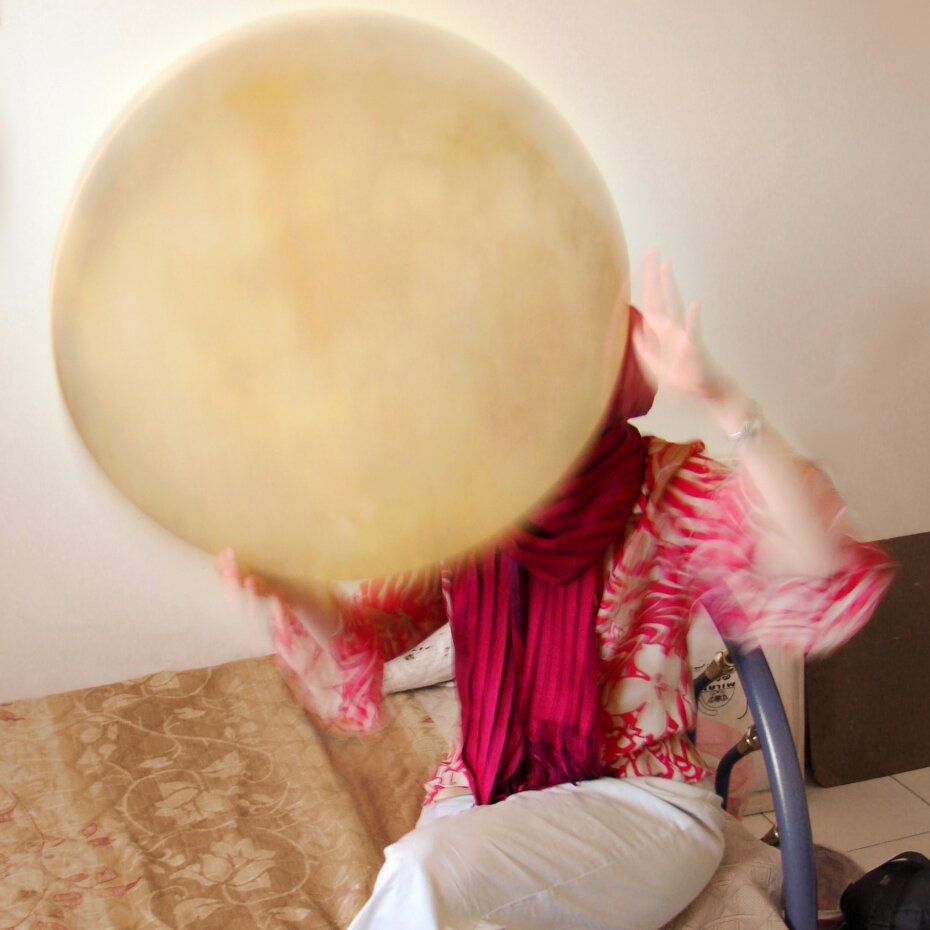The Daf (also known as the Daff) is a frame drum with a single skin and has a long history going back as far as the early dynastic period. Although the instrument is very simple – made from a wooden frame covered with skin – it is characterized by the complex rhythms that can be played on it, but also by a highly sophisticated playing technique and an outstanding versatile sound, which is mainly created by the ring chain inside the frame. The Daf is deeply rooted in the music canon of Central Asia and the Middle East. Since the 1980s, it has been spread more and more often outside its traditional area. With the worldwide dissemination of frame drums such as the Daf, experts now speak of an independent, contemporary frame drum culture.
The Daf's current appeal to international musicians is attributed to the deep historical and cultural roots of the drum, which go back to Mesopotamia, as well as the connection to spiritual practices such as Sufism. In recent years, there have been remarkable innovations in playing the Daf by way of mixing different frame drum and rhythm traditions. The instrument was influenced by several highly individual approaches of percussionists from all over the world.
The symbiosis of individual styles and traditional aspects (such as playing technique, instrument history and rhythm) are propelling the instrument to evolve, even outside the Middle East. That is why the Daf is appreciated by many musicians from all over the world as a means of expression, whether with or without the artists' cultural roots. Today, major international Daf players include Mohammad Reza Mortazavi, Naghmeh Farahmand, David Kuckhermann, Rowan Storm, Madjid Khaladj, Kourosh Moradi, Pezhham Akhavass, Mohsen Taherzadeh and Glen Velez.
Nowadays, a strong Daf tradition exists in the Kurdish areas of Iraq and Iran. Since 2011, in the city of Sanandaj a festival for this instrument is being celebrated every year – the festival of the one thousand Daf drums. Hundreds of Daf musicians meet there. With this festival, Sanandaj aims to become the world capital of the Daf. Among the major Kurdish Daf players are musicians such as Hajar Zahawy and Asal Malekzadeh.
What is the difference between the Daf and other frame drums?
The Daf is a relatively large frame drum. It has a diameter of about half a meter. Inside the wooden frame of the Daf there is a chain consisting of four metal rings connected to each other. Metal rings are also attached to the inside of other frame drums. The Uzbek Doira or the Azerbaijani Ghaval, however, only contain single rings. The player strikes the Daf with bare hands, while a mallet is used for similar instruments such as the Bodhrán or the shaman drums.
The Daf's playing technique is based on the coordination of hands, fingers, wrists and arms. The drum is held and played by the hands at the same time as the arms move the instrument up and down. When the more than 300 rings attached to the inside of the drum strike against the drum's skin, various shaking effects occur. The various hand and finger techniques for the Daf allow a unique sound spectrum from loud, explosive sounds and deep bass sounds to subtle, delicate beats.
In Iran, Iraq, Syria, Azerbaijan and Tadzhikistan, the Daf not only plays a role in popular music, but is also present in the classical repertoire. Frame drums also play an important role in folk music and in the context of religious ceremonies. In the 20th century, mainly Sufi musicians had a strong impact on the instrument and made it popular. During the trance ceremonies of Sufism, for example the Dhikr dance of the Dervish, the Daf is often played together with the flute Nay.
The Daf – a women’s instrument?
The Daf is played solo, but also in groups in unison. It is one of the few instruments in the Middle East that is also played by women. Although the Daf is historically and currently a heavily female-dominated instrument, the music practice of women in the Middle East is now much less visible and perceptible in public than the musical performance of men. Today, women play the Daf predominantly in private contexts, for entertainment, when they are only among themselves. One of the rare public occasions for which women perform on the instrument are weddings (e.g. in Afghanistan). Then, the women play music with the Daf, sing and dance. In countries such as Afghanistan, Iraq and Azerbaijan, the Daf is one of the few traditional instruments that women are allowed to play at all.
Nevertheless, the connection of women as frame drum players can be traced back to the early history of the instrument. Frame drums have their historical roots in Mesopotamia, the Mediterranean region, in ancient Egypt and the Arabian Peninsula. Statues and figures that date back to 3000 B.C. depict women who play the frame drum on important social occasions such as religious ceremonies, dirges, temple rituals or processions. Traditionally, in Arab culture women played the Daf during battles and thus cheered the warriors. The elegies for heroes were also sung by women who accompanied themselves on the frame drum. Usually, drum playing, singing and dancing were closely connected in these contexts. At the time, women were visible as instrumentalists. They played outside their own four walls, on the streets, in temples, at processions, on rooftops or on the edge of a battlefield.
However, the public opportunities, where women played have been severely limited over the centuries. The major Persian Daf players today include the Safahan Music Ensemble, Khalifeh Rahmeh, Shekoofeh Pariab, Negar Ezazi and Noushin Aghighi.
